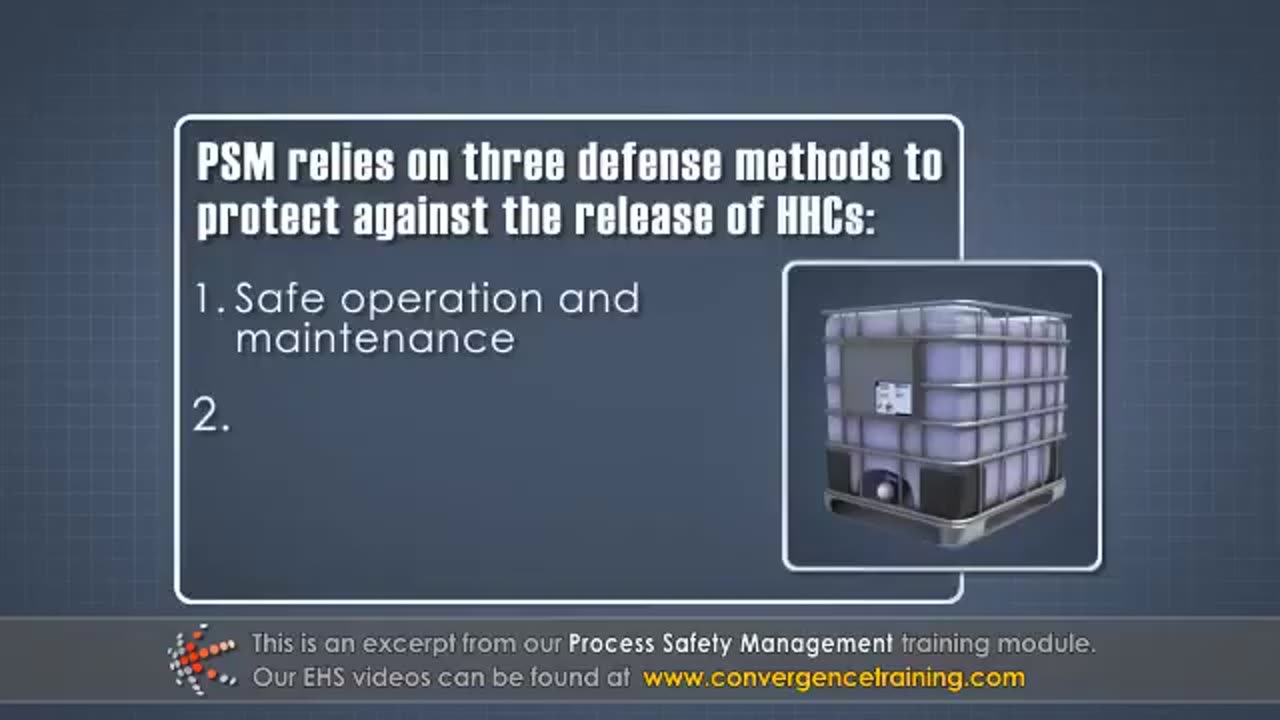Premium Only Content

Process Safety Management Training
**Process Safety Management (PSM) Training** is designed to ensure workers understand the principles of preventing releases of hazardous chemicals and maintaining safe operations in processes involving highly hazardous substances. This training aligns with OSHA’s **Process Safety Management Standard (29 CFR 1910.119)** and is critical for industries such as chemical manufacturing, oil and gas, and pharmaceuticals.
---
### **Process Safety Management (PSM) Training Outline**
#### **1. Introduction to Process Safety Management**
- **What is PSM?**
- A systematic approach to managing processes involving highly hazardous chemicals.
- Focused on preventing catastrophic releases and incidents.
- **Why is PSM important?**
- Protects employees, communities, and the environment.
- Ensures compliance with OSHA regulations and industry best practices.
- Overview of OSHA’s **14 Elements of PSM**.
---
#### **2. Overview of Highly Hazardous Chemicals (HHCs)**
- Definition of HHCs:
- Chemicals with high potential for causing significant harm if released.
- Examples of HHCs:
- Flammable gases, toxic substances, and reactive chemicals.
- Recognizing hazardous processes in the workplace.
---
#### **3. Key Elements of the OSHA PSM Standard**
1. **Process Safety Information (PSI):**
- Collecting and maintaining data on hazardous chemicals, process technology, and equipment.
2. **Process Hazard Analysis (PHA):**
- Identifying and evaluating risks through tools like HAZOP or What-If analysis.
- Frequency and team composition for PHA reviews.
3. **Operating Procedures:**
- Developing and maintaining written instructions for safe operation.
- Including emergency shutdown procedures.
4. **Training:**
- Ensuring employees understand their roles in process safety.
- Periodic refresher training requirements.
5. **Mechanical Integrity:**
- Regular inspection, testing, and maintenance of critical equipment.
- Preventing equipment failures that could lead to hazardous releases.
6. **Management of Change (MOC):**
- Controlling risks associated with modifications to processes, equipment, or procedures.
7. **Incident Investigation:**
- Analyzing incidents and near-misses to identify root causes and implement corrective actions.
8. **Emergency Planning and Response:**
- Preparing for and responding effectively to chemical releases or other emergencies.
9. **Compliance Audits:**
- Regularly evaluating PSM program effectiveness and addressing deficiencies.
(Include the remaining OSHA PSM elements, depending on the audience's needs.)
---
#### **4. Hazard Identification and Risk Assessment**
- Identifying potential hazards in processes:
- Chemical reactivity, overpressurization, or equipment failures.
- Assessing and mitigating risks:
- Using tools like Bow-Tie Diagrams or Layer of Protection Analysis (LOPA).
- Importance of safety-critical systems and safeguards.
---
#### **5. Safe Work Practices**
- Examples of safe work practices:
- Lockout/Tagout (LOTO).
- Permit-to-Work (PTW) systems.
- Hot work permits and precautions.
- Ensuring consistency between work practices and operating procedures.
---
#### **6. Emergency Response Preparedness**
- Preparing for emergencies involving hazardous chemicals:
- Developing and practicing emergency action plans.
- Understanding the role of Emergency Response Teams (ERTs).
- Communicating with local emergency responders and community stakeholders.
---
#### **7. Roles and Responsibilities**
- **Employer responsibilities:**
- Implementing and maintaining an effective PSM program.
- Providing resources, training, and tools to manage process safety.
- **Employee responsibilities:**
- Adhering to operating procedures and reporting safety concerns.
- Actively participating in training and safety programs.
---
#### **8. Real-Life Case Studies**
- **Case study examples:**
- The Bhopal disaster (1984) – lessons in chemical safety.
- Texas City Refinery explosion (2005) – importance of mechanical integrity.
- Deepwater Horizon spill (2010) – role of management systems in prevention.
- Discussion of key takeaways and actionable lessons.
---
#### **9. Practical Exercises and Scenarios**
- Conducting a mock Process Hazard Analysis (PHA).
- Role-playing Management of Change (MOC) scenarios.
- Simulating emergency response to a chemical release incident.
---
#### **10. Quiz and Certification**
- Administer a knowledge assessment to test understanding.
- Provide certificates for participants who successfully complete the training.
---
Would you like this training tailored for specific processes or industries? I can also assist in developing presentations, quizzes, or detailed materials for the course.
-
 1:35
1:35
HSESafetyInformation
1 month agoMutton Chops two ways- baked & grilled Recipe by Food Fusion (Eid Recipe)
53 -
 41:03
41:03
Kimberly Guilfoyle
7 hours agoTrump approval up, Dems melting down. Live with Asm Bill Essayli & Jarrett Stepman | Ep206
91.1K19 -
 59:20
59:20
Candace Show Podcast
5 hours agoSo… The “Conspiracy Theorists” Were Right About JFK | Candace Ep 164
122K193 -
 1:10:15
1:10:15
Sarah Westall
3 hours agoIs Trump bringing the US through a Bankruptcy Reorganization? Planning for Reset w/ Andy Schectman
25.8K3 -
 LIVE
LIVE
Mally_Mouse
2 hours agoLet's Play!! - R.E.P.O. - w/ friends
94 watching -
 54:49
54:49
LFA TV
1 day agoCan Donald Trump Bring Peace? | TRUMPET DAILY 3.20.25 7PM
23.5K1 -
 1:34:34
1:34:34
vivafrei
10 hours agoLive with Gad Saad! Tesla on Fire! Canada on TDS! And "Suicidal Empathy" Turns Violent? Viva Frei
141K62 -
 1:12:11
1:12:11
The Officer Tatum
5 hours agoLIVE: JFK Files Update, Wesley Hunt vs. D.L. Hughley, YouTube Challenge GOES WRONG & More | EP 82
58.1K37 -
 1:36:03
1:36:03
Tucker Carlson
1 day agoBob Lighthizer: Why Trump's Tariffs are the Only Way to Save the Middle Class
156K145 -
 1:01:23
1:01:23
In The Litter Box w/ Jewels & Catturd
1 day agoTESLA TERRORISM | In the Litter Box w/ Jewels & Catturd – Ep. 766 – 3/20/2025
94.8K20